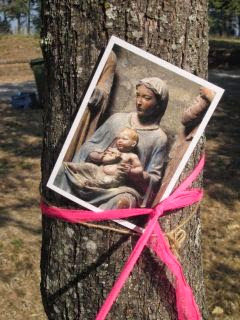" Fountain 51. Cantal. wishes for Ali. cold and wet."
were the only comments I made in my very weathered fountain notebook.
And now, nearly a year later, how clear the olfactory memories are:
fresh rain on dusty tarmac and low clouds tinged with the warm honey scent of gorse flowers.
fresh rain on dusty tarmac and low clouds tinged with the warm honey scent of gorse flowers.
Nevertheless, the rain had already sodden my gloves and boots hours ago.
My wet hands and feet were freezing and the intrepid explorer in me
wanted only a dry tent, a hot shower and a nice cup of tea.
My wet hands and feet were freezing and the intrepid explorer in me
wanted only a dry tent, a hot shower and a nice cup of tea.
If there was a campsite nearby it was hidden in the mists of this high and remote area.
The fuel warning light had been illuminated for quite a while, like an elbow poke, warning me something like, "no pressure but you might get stranded here, soaked to the skin with an equally wet tent in the middle of nowhere with one shriveled carrot and a half a bag of peanuts."
Despite the thousands of miles I've driven in France, I've never been able to fully understand the French relationship to petrol stations.
Italy seems to have an unannounced petrol station every few hundred yards.
In France, I've grown to doubt the road signs for the various supermarkets with their promise of 24/7 petrol. Too many times I have driven miles off course chasing an illusive E.Leclerc or Carrefour to discover that the petrol station was shut for lunch or because it is after 7pm and my credit card is rejected by the self-service machine.
Rioms' fountain was built up against the church wall which is a bit unusual.
(I am trying to be more careful with my "never seen this before"exclamations which only prove how unobservant I really am.)
Oops sorry sorry sorry... this cute little wonky Jesus was actually in Rioms
not "Fountain 50 Roffiac 25 August"












